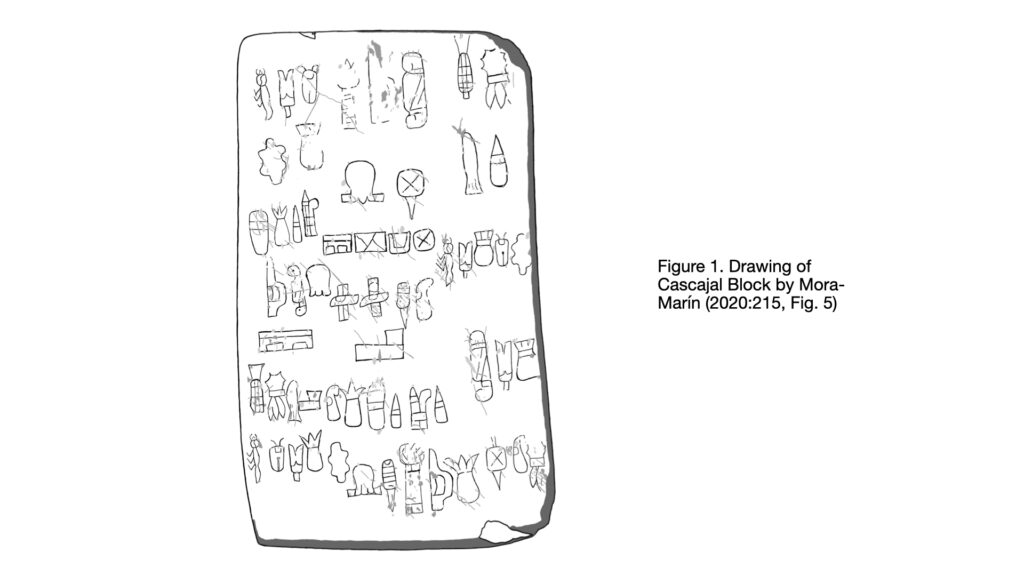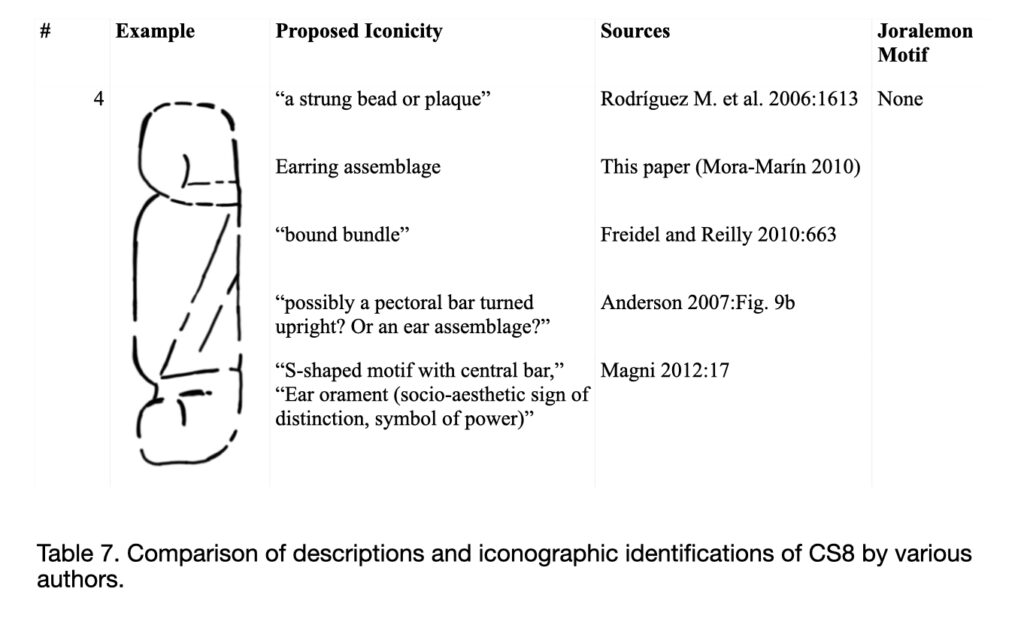The Cascajal Block: Iconographic Motivations, Part 2
David F. Mora-Marín
davidmm@unc.edu
University of North Carolina
Chapel Hill
10/8/2023, 10/10/2023
This is a continuation of the sub-series begun with Note 26 (Mora-Marín 2022), which outlined possible iconographic motivations for the four most frequent signs on the Cascajal Block (Rodríguez et al. 2006a, 2006b). My original manuscript (Mora-Marín 2010) on this topic will once again serve as the basis for this second installment, though this note also incorporates scholarship that has become available since then (Magni 2012; Carrasco and Englehardt 2015).
The methodology I established in that manuscript, and reproduced in my Note 26, is repeated here in full:
- Use Joralemon’s (1971) motif catalog to identify signs in the Cascajal signary, a task not attempted in Rodríguez et al. (2006a), and only selectively in Rodríguez and Ortiz (2007), who provide Joralemon numbers for CS6, CS16, and CS1/12/27.
- Restrict comparisons to Early and Middle Preclassic Olmec-style art to the extent that is possible, and avoid comparisons with much later writing and artistic traditions as much as possible.
- Include iconographic sources for such motifs to determine whether the identification is plausible, whenever Joralemon’s gloss or description of the motif is not sufficient or available.
- Check against the identifications proposed in Rodríguez et al. (2006a), Justeson (2006, 2012), Ortiz et al. (2007), Rodríguez and Ortiz (2007), Anderson (2007), Mora-Marín (2009), Freidel and Reilly (2010), Magni (2012[2008]), and Carrasco and Englehardt (2015).
This time, however, I will examine five of the ten signs that occur three times within the Cascajal Block text. Before proceeding, I will once again provide a drawing of the Cascajal Block’s inscription (Figure 1) and my revised signary organized by sign frequency (Figure 2) (Mora-Marín 2020).
Figure 1
Figure 2
The following signs will be discussed in this note: CS4–CS8 and CS24–25.
I begin then with CS4. Table 1 presents the relevant descriptions and identifications by a variety of authors. Figure 3 presents the comparison I offered in Mora-Marín (2010); a similar comparison is offered in Mora-Marín (2020:221). I consider CS4 to be a representation of an ant. The sign shows an insect, as indicated by the three legs, which assuming bilateral symmetry, suggest the six legs of an insect, and disqualifying arachnids, which have eight. The body (Figure 3a) shows three major sections, consistent with the three major sections of insects (head, thorax, abdomen). The head of the insect represented by CS4 shows two mandibles and a central triangular element. These traits are all consistent with the morphology of an ant (Figure 3b). Bees, to my knowledge, lack mandibles, and while they have a proboscis, which could be argued to match the central triangular element seen on CS3, the fact is that some ants have a section between the mandibles, the clypeus, that is very pronounced in some types of ants, and could be represented as a triangular element (Figure 3c).
Table 1
Figure 3
This paper regards CS5 (Table 2) to be a depiction of a human or human-like eye, a suggestion also offered by Magni (2012). The shape of the outline is not (Figure 4a), at first, very consistent with the outline of a human eye (Figures 4b–c), which is typically almond-shaped. However, some examples of human eyes in Olmec art, resemble a backward-curving thumb (Figures 4d–e), and are thus consistent with the shape of CS5.
Table 2
Figure 4
I also support the possibility that CS24 and CS25, each occurring only once on the Cascajal Block, represent “banded eyes” (Tables 3–4). The difference lies in the absence of circles within the bands in CS24 (Figure 5) and their presence (Figure 6) within the band in CS25.
Tables 3–4 provide summaries of the proposals regarding CS24 and CS25. Rodríguez M. et al. (2006:1613) consider both CS24 and CS25 (their CS23 and CS24) to represent, together, “paired sets of eyes.” I regard CS24 (Figure 5a) to be a depiction of the Olmec banded eye motif identified by Joralemon as his motif #7 (Figures 5b–c), and CS25 (Figure 6a) to be a depiction of the Olmec banded eye motif also classified by Joralemon as motif #7, but a version that shows dots or circles placed along the length of the band (Figures 6b–c). In the iconographic examples, the circles may appear outside the band (Figure 6b) or contained within a band (Figure 6c); the latter version agrees with CS25 more closely, for it shows the circles contained within the band. The shape of the eye depicted in CS24 and CS25 is closely matched by the shape of the eye in the example from the Las Limas figurine (Figure 6b).
Table 3
Figure 5
Table 4
Figure 6
Table 5 provides a summary of proposals regarding CS6. This paper regards CS6 (Figure 7a) to be a depiction of the skin/pelt of a mammal, like all other authors commenting on the matter have to date, and thus a PELT motif. And like most of the other authors have observed, CS6, although highly simplified, can be compared to the Atlihuayan clay figurine (Figure 7b), a representative of Joralemo’s Motif 66. Taking into account the neck and head, the four extremeties, and the tail, we can count six projections. Epi-Olmec writing exhibits a sign, MS33 (Figure 7c) (Macri and Stark 1993), that also depicts an animal hide with six projections, and like the example from Atlihuayan, Morelos, it bears a diamond-shape element that could represent a hole in the hide (Justeson and Kaufman 1993:1707, Fig. 8B). The possible Mayan counterpart, ZZ3/T628 (Figure 7d), proposed to function as a logogram for ‘blood’ by David Stuart, bears general outline similarities, but also important differences.
Table 5
Figure 7
Table 6 summarizes the proposals for the iconicity of CS7, and Figure 8 illustrates all three instances. Here, no proposal is favored, and no new suggestion is offered. Although a few authors offer suggestions for its iconicity (see Table 6), there exist no close iconographic parallels to support such suggestions.
Table 6
Figure 8
Table 7 provides a summary of proposals regarding CS8. This paper regards CS8 (Figure 9a) to be a depiction of “a strung bead or plaque,” as proposed by Rodríguez M. et al. (2006:1613), and plausibly of the type seen in earring assemblages, for which the evidence from Epi-Olmec writing is suggestive but not completely in agreement; at least three types of earring assemblages are visible in the iconography of Epi-Olmec writing, two of them shown here (Figures 9b–c). The closest correspondence to the putative example represented by CS8 would be a combination of two of the three types seen in Epi-Olmec writing (Figure 9d). CS8 may also resemble Mayan T62/ZBF yu, but the central component in the Mayan grapheme is always rounded and typically contains a circular element in the middle, rather than a diagonal band.
Table 7
Figure 9
The evidence presented in this note, based on an unpublished paper (Mora-Marín 2010) that has been cited in a few works (Freidel and Reilly 2010; Carrasco and Englehardt 2015), further supports the consistency of the Cascajal signary, from a stylistic-iconographic standpoint, with contemporary Olmec art and subsequent Epi-Olmec writing, and offers new insights into some iconographic identifications for such signs, as well as supports for identifications proposed by others. Future installments will provide similar assessments for the remaining signs in the Cascajal signary.
References

















